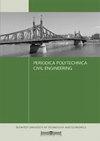Experimental Analysis of an Innovative Double Strap Joint Splicing of GFRP Bars by NSM Methods for Strengthening RC Beams
IF 1.4
4区 工程技术
Q3 ENGINEERING, CIVIL
引用次数: 0
Abstract
The double strap joint splicing of glass fiber reinforced polymer (GFRP) bars for reinforced concrete (RC) beams strengthening, applying the near surface mounting (NSM) method, has been proposed in the paper. The proposed method consists of application of the supplementary GFRP bars symmetrically positioned in the cut-off zone of the main GFRP reinforcement. The performances of this splicing method have been experimentally tested for the most unfavorable case of the GFRP reinforcement cut-off in the maximal bending moment zones. During the experiment, the varied parameter has been overlapping length of the bars, taking values of 20∅ and 40∅. Evaluation of the splicing technique is done comparing the experimental results with the results of the behavior of beams strengthened by GFRP bars without cut-off and with cut-off, but without splicing. Experimental research encompassed analysis of strength, stiffness, ductility, crack pattern, strains in the steel, GFRP reinforcement and concrete, and the failure modes of the beams. It has been shown that in case of the cut-off of the GFRP bar, strengthening effectivity decreases for 39%, and that in the case of bypassing the cut-off using double strap 20∅ and 40∅ long, strengthening effectivity decreased 23%, and 14% respectively, compared to the beam without GFRP bar cut-off. Using extrapolation, it has been shown that double strap with length of 60∅ provided strength equivalent to the case without cut-off. The result of application of this splicing method of the additional GFRP bars is significant increase of strength and serviceability of the strengthened RC beams.新型GFRP筋双带拼接法加固RC梁的试验分析
采用近表面安装法,提出了玻璃纤维增强聚合物(GFRP)钢筋双带接缝拼接加固钢筋混凝土梁的方法。所提出的方法包括在GFRP主筋的截止区域对称地应用辅助GFRP筋。在GFRP筋在最大弯矩区切断的最不利情况下,对这种拼接方法的性能进行了试验测试。在实验过程中,各参数重叠条形图的长度,取值分别为20∅和40∅。将试验结果与不截断和截断不截断GFRP筋加固梁的性能结果进行比较,对拼接技术进行了评价。试验研究包括强度、刚度、延性、裂缝模式、钢、玻璃钢加固和混凝土的应变分析,以及梁的破坏模式。研究结果表明,玻璃钢隔断时,加固效果下降39%;采用双带20∅和40∅长绕过隔断时,加固效果比不设玻璃钢隔断的梁分别下降23%和14%。通过外推可知,长度为60∅的双表带在不切断的情况下提供与表壳等效的强度。采用这种附加GFRP筋的拼接方法,加固后的钢筋混凝土梁的强度和使用性能明显提高。
本文章由计算机程序翻译,如有差异,请以英文原文为准。
求助全文
约1分钟内获得全文
求助全文
来源期刊

Periodica Polytechnica-Civil Engineering
工程技术-工程:土木
CiteScore
3.40
自引率
16.70%
发文量
89
审稿时长
12 months
期刊介绍:
Periodica Polytechnica Civil Engineering is a peer reviewed scientific journal published by the Faculty of Civil Engineering of the Budapest University of Technology and Economics. It was founded in 1957. Publication frequency: quarterly.
Periodica Polytechnica Civil Engineering publishes both research and application oriented papers, in the area of civil engineering.
The main scope of the journal is to publish original research articles in the wide field of civil engineering, including geodesy and surveying, construction materials and engineering geology, photogrammetry and geoinformatics, geotechnics, structural engineering, architectural engineering, structural mechanics, highway and railway engineering, hydraulic and water resources engineering, sanitary and environmental engineering, engineering optimisation and history of civil engineering. The journal is abstracted by several international databases, see the main page.
 求助内容:
求助内容: 应助结果提醒方式:
应助结果提醒方式:


